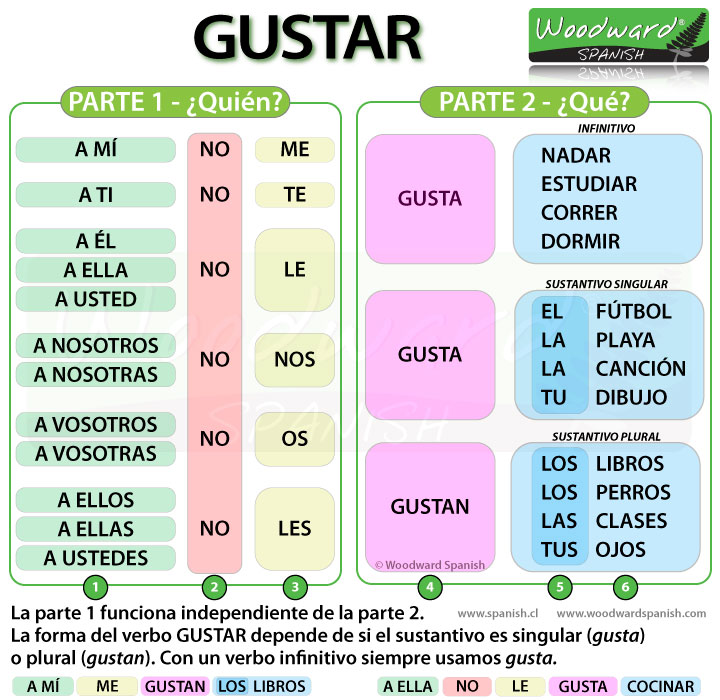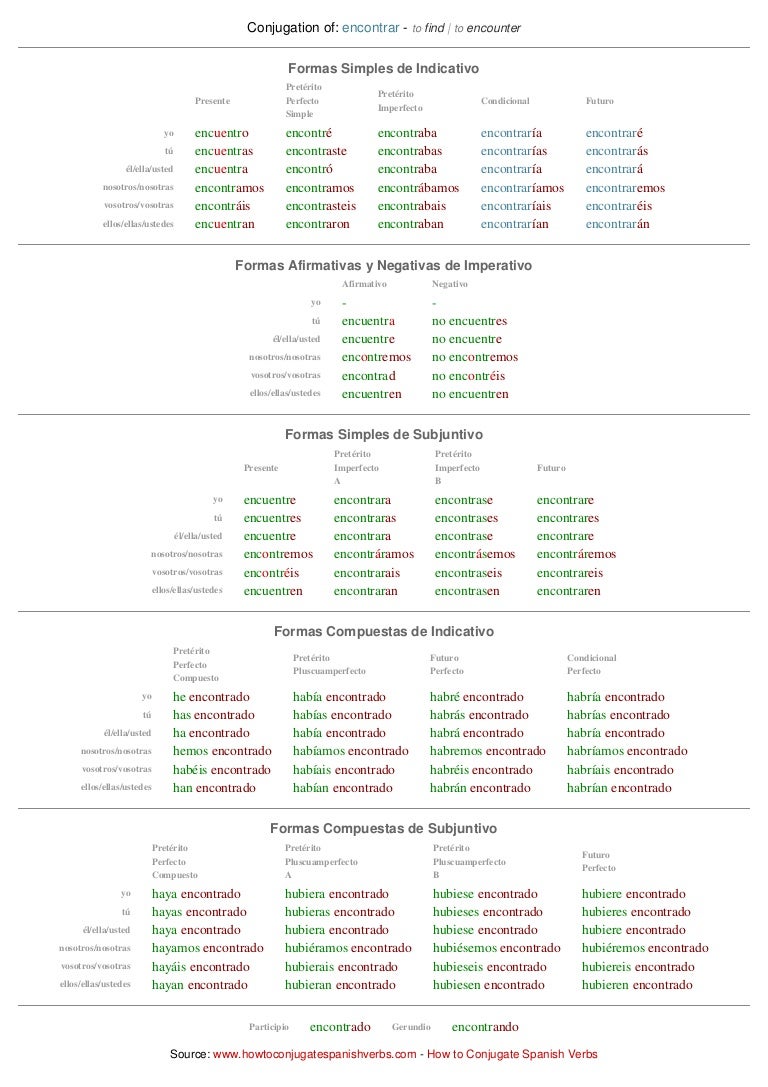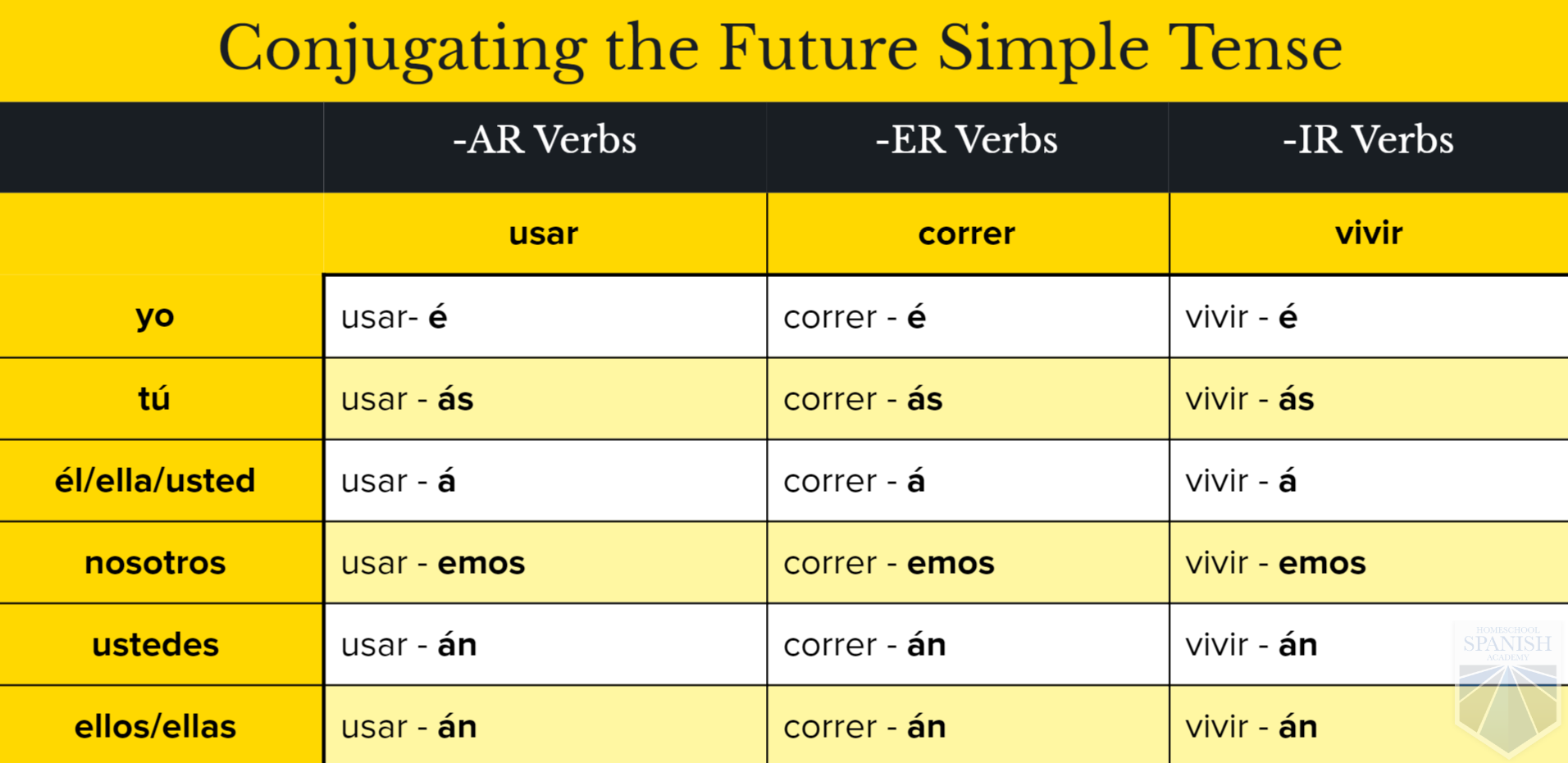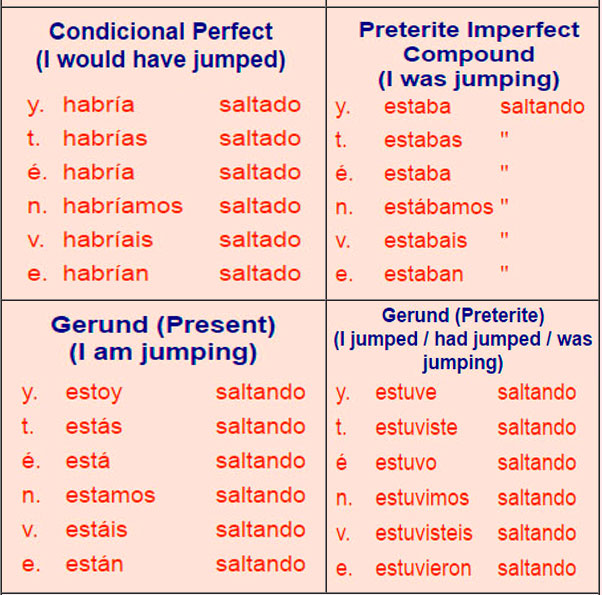We must explain that this Free Online Bilingual Dictionary includes all of our products that you can find in our products page. On top of that, it offers English and Spanish pronunciation, separation into syllables and grammar attributes. It also accepts conjugated verbs and Spanish feminine and plural forms as valid entries. The future has two main forms in Spanish, the imperfect future and the simple one.
The compound future is done with the conjugated ir (which means "to go," but may also mean "will" in this case) plus the infinitive and, sometimes, with a present progressive verb added as well. The conjugation for vos is usually only different from the tú conjugation in the present tense and the imperative , though there can be differences in the preterite and subjunctive as well. Sometimes the present tense conjugation is identical to the tú conjugation . For the present tense conjugation of ser, in some regions of Chile, Colombia, and Cuba the vos conjugation is soi, whereas in some parts of Panama and Venezuela it is sois. A final -s may or may not be used for the vos conjugation in the preterite tense. There is a lot of variation in the vos conjugations, in addition to the use of the pronoun tú with a vos conjugation or the pronoun vos with a tú conjugation.
Voseo is usually associated with Argentina but there are many more places in Latin America that use vos in some form so it is important to be aware of it. The pronoun will still need to change to reflect who is receiving the reflexive action. For example, to talk about something you plan to do right away, you add the present tense form of ir ("to go") and a ("to") to the infinitive of the main verb that describes the action being taken. The indicative mood has five simple tenses, each of which has a corresponding perfect form. In older classifications, the conditional tenses were considered part of an independent conditional mood, but now are grouped with the indicative. Continuous forms are usually not considered part of the verbal paradigm, though they often appear in books addressed to English speakers who are learning Spanish.
Modern grammatical studies count only the simple forms as tenses, and the other forms as products of tenses and aspects. For many English speakers, learning all the conjugations of Spanish can be difficult enough. Once you get into choosing between the two versions of "to be", you feel like you could almost give up. As soon as your "ah-ha" moment arrives, you'll just have to worry about putting it into practice. Even people who have been studying Spanish or living in a Spanish-speaking country for a long time can get mixed up and make these mistakes.
In English, we use the pronouns "myself, yourself, himself, herself, themselves" to express the "who" that's receiving the action. Reflexive verbs are a type of pronominal verb, which means they include or relate to a pronoun. In Spanish, the reflexive pronouns "me, te, se, nos, os" are used in the same way. ⇒ As you now know, reflexive verbs require the use of reflexive pronouns to indicate that the direct object of the verb is also the subject . Reflexive verbs "reflect" the action back upon oneself, meaning that the person performing the action is also the one receiving it.
This reflective meaning is inherent in some verbs, while others require specification that the action is being done back to the subject. For example, someone can't "repent" for someone else, only the subject can initiate this action. But with a verb like "wash," the subject of the sentence could be washing themselves or some other object. Spanish also has verbs that are considered inherently reflexive (not the same ones as English!), and some that can become reflexive in certain scenarios. Reflexive verbs indicate that the action of the verb reflects back on the subject.
Hopefully you weren't overwhelmed by learning the Spanish present tenses. It's the most commonly used tense, but it's just as important to learn the preterite and future tenses. We'll go over the conjugations for the regular verbs we used above. When these verbs are used with adjectives, the difference between them may be generalized by saying that ser expresses nature and estar expresses state. Frequently—although not always—adjectives used with ser express a permanent quality, while their use with estar expresses a temporary situation. There are exceptions to the generalization; for example, the sentence "Tu mamá está loca" ("Your mother is crazy") can express either a temporary or a permanent state of craziness.
Perhaps the verb that English speakers find most difficult to translate properly is "to be" in the past tense ("was"). Apart from the choice between the verbs ser and estar , it is often very hard for English speakers to distinguish between contextual and narrative uses. As stated above, deciding whether to use the preterite or the imperfect can present some difficulty for English speakers. But there are certain topics, words, and key phrases that can help one decide if the verb should be conjugated in the preterite or the imperfect. These expressions co-occur significantly more often with one or the other of the two tenses, corresponding to a completed action or a repetitive action or a continuous action or state in the past. The plural vosotros is always the same as the infinitive, but with a final -d instead of an -r in the formal, written form; the informal spoken form is the same as the infinitive.
The singular vos drops the -r of the infinitive, requiring a written accent to indicate the stress. The imperative mood has three specific forms, corresponding to the pronouns tú, vos, and vosotros (tú and vos are used in different regional dialects; vosotros only in Spain). These forms are used only in positive expressions, not negative ones.
The subjunctive supplements the imperative in all other cases (negative expressions and the conjugations corresponding to the pronouns nosotros, él/ella, usted, ellos/ellas, and ustedes). The original question was how to translate, "Do not be bored." My question to the original poster was to encourage him to try to discover which verb to use. Then it would be a simple matter of conjugating that into the imperative.
In this lesson we study the Spanish verb ''aburrir'', which means 'to bore' or 'to get bored', depending on the context. We'll see its uses through different conversations and examples, as well as its present tense conjugation. In English, we sometimes use the word "commit" in front of reflexive verbs, such as "to perjure" , meaning to lie under oath, which can only be done by the person in question back "to" that same person.
In Spanish, reflexive verbs are commonly used to talk about motion, your own body, your clothing, your state of mind, and your routines. It tends to express a certain nuance of obligation and a certain nuance of future tense, much like the expression "to be to". It is also often used similarly to tener que and deber ("must", "ought to").
Note that the third personal singular of the present tense is ha. Haber derives from Latin habeō, with the basic meaning of "to have". Tener derives from Latin teneō, with the basic meaning of "to hold", "to keep". In English, the sentence "The boy is boring" uses a different adjective than "The boy is bored". In Spanish, the difference is made by the choice of ser or estar. The differences between ser and estar are considered one of the most difficult concepts for non-native speakers.
Both ser and estar translate into English as "to be", but they have different uses, depending on whether they are used with nouns, with adjectives, with past participles , or to express location. Sometimes expressions like "today", "this year", and "this week" are used to express the idea these periods are over. For example, in December one might speak of the year in the simple past because we are assuming that all of that year's important events have occurred and one can talk as though it were over. Other expressions—such as "this weekend," if today is Monday—refer to a period which is definitely over; the word "this" just distinguishes it from other weekends. There is a tendency in Spanish to use the perfect even for this type of time reference, even though the preterite is possible and seems more logical. The difference between the preterite and the imperfect is often hard to grasp for English speakers.
English has just one past-tense form, which can have aspect added to it by auxiliary verbs, but not in ways that reliably correspond to what occurs in Spanish. Spanish has two fundamental past tenses, the preterite and the imperfect. Strictly speaking, the difference between them is one not of tense but of aspect, in a manner that is similar to that of the Slavic languages. However, within Spanish grammar, they are customarily called tenses.
The future tense of the subjunctive mood is also obsolete in practice. As of today, it is only found in legal documents and the like. In other contexts, the present subjunctive form always replaces it.
There is no strict distinction between simple and continuous forms in Spanish as there is in English. In English, "I do" is one thing and "I am doing" is another . In Spanish, hago can be either of the two, and estoy haciendo stresses the latter. Although not as strict as English, Spanish is stricter than French or German, which have no systematic distinction between the two concepts at all. This optionally continuous meaning that can be underlined by using the continuous form is a feature of the present and imperfect.
The preterite never has this meaning, even in the continuous form, and the future has it only when it is in the continuous form. In Spanish grammar, continuous tenses are not formally recognized as in English. However, one can also say sigo leyendo ("I am still reading"), voy leyendo ("I am slowly but surely reading"), ando leyendo ("I am going around reading"), and others. Tenses supported include present, past and future , the various perfect forms, conditional and imperative.
You can also learn gerund, past participle and verb meanings. We use the present indicative to talk about habits or things that happen regularly. We can also use it to make descriptions or talk about facts. For example, you can express what bores you the most or what you like to do when you get bored.
⇒ Remember, the reflexive pronoun will always be the same number and person as the subject of the sentence. ⇒ When the object of the verb is the same entity as the subject, you will need to use a reflexive pronoun that matches the subject of the verb in both number and person . The revision helps you learn more or less how the verbs work. But it's by actually speaking and communicating and using the verbs as you talk to people that the small number of verbs and tenses you need get cemented in your brain. Before I describe my process for learning to conjugate verbs, let's look at the very basics of Spanish verb conjugation.
But I don't think it's the only way to master verb conjugation. When you're learning Spanish, Spanish verb conjugation rarely inspires enthusiasm, even in the most dedicated language learner. Sign up for Lingvist's online Spanish course today to continue learning how to express yourself in a new language! You can also check out this reference list of reflexive verbs.
The negation ("no") goes in front of the reflexive pronoun, except when the pronoun is attached to a gerund or infinitive, in which case it goes in front of the conjugated verb. Although ser and estar both mean "to be," to the native Spanish speaker they don't mean the same thing. As a result, some adjectives can change in meaning depending on whether they're used with ser or estar. Remember that the reflexive pronoun (me, te, se, etc.) must be included with the verb, even if the subject pronoun (yo, tú, él, etc.) is not. Conjugation requires removing the -se ending and conjugating normally. The reflexive pronouns are then placed before the conjugated form of the verb.
So to help you get to all this good stuff, the following phrases will run through various ways to express a variety of emotions—from happiness to anger to surprise. Beginners can use this article to learn the basics of expressing emotion in Spanish, while more advanced speakers can move beyond the basics and learn colloquial phrases and more specific vocabulary. Only ser is used to equate one noun phrase with another, and thus it is the verb for expressing a person's occupation ("Mi hermano es estudiante"/"My brother is a student"). The other constructions detailed above are used instead. Indeed, in some areas, such as Argentina and Uruguay, speakers hardly use the future tense to refer to the future. The choice between present subjunctive and imperfect subjunctive is determined by the tense of the main verb of the sentence.
All the compound tenses are formed with haber followed by the past participle of the main verb. Haber changes its form for person, number, and the like, while the past participle remains invariable, ending with -o regardless of the number or gender of the subject. Grammatical mood is one of a set of distinctive forms that are used to signal modality. In older classifications there was a fourth mood, the conditional, that included the two conditional tenses , but nowadays those tenses are included in the indicative mood.
The 16 "regular" forms include 8 simple tenses and 8 compound tenses. The compound tenses are formed with the auxiliary verb haber plus the past participle. Verbs can be used in other forms, such as the present progressive, but in grammar treatises they are not usually considered a part of the paradigm but rather periphrastic verbal constructions.
The modern Spanish verb paradigm has 16 distinct complete forms , i.e. sets of forms for each combination of tense, mood and aspect, plus one incomplete tense , as well as three non-temporal forms . Two of the tenses, namely both subjunctive futures, are now obsolete for most practical purposes. The verb must be conjugated into the imperative mood in order to say, "Do not get bored." Add the reflexive pronouns (me/te/se/nos/os/se) in front when the verb means 'to get bored'. In some cases, the choice of either ser or estar will completely change the meaning of a sentence.
Express a condition or feeling by adding a descriptive adjective after estar. ⇒ Reflexive verbs can also be used to indicate an emotional response to something. When a person becomes angry, sad, happy, etc., you can express this by using reflexive verbs. When it comes to verb conjugation in particular, speaking Spanish regularly will help you sort all this out in your mind. Everything will come together when you combine targeted study with daily conversation. That's one reason why my process for learning verb conjugation relies so much on regular communication in Spanish.
Whenever you describe something that you do to your own body , you will also need to make the verb reflexive. For example, lavar ("to wash") isn't always used to talk about washing oneself. But, just as in English, adding the reflexive pronoun changes that. Reflexive verbs can be used to describe an "exchange" of action, or a reciprocal event, between two or more parties.
In this case, the reflexive pronouns "os" or "nos" indicate that the action is reciprocal. Let's go over the basics of what you'll need to know for the most common types of Spanish verb conjugations, persons and tenses. In addition, Spanish has many verb tenses—like the subjunctive and the conditional—which allow speakers to delicately express shades of emotion and meaning. Used to express someone's physical appearance, personality, origin, and occupation; the verb ser is a really important word to learn in Spanish. While it is an irregular verb, the changes are not difficult to remember.
Tener is a verb with the basic meaning of "to have", in its essential sense of "to possess", "to hold", "to own". As in English, it can also express obligation (tener que + infinitive). It also appears in a number of phrases that show emotion or physical states, expressed by nouns, which in English tend to be expressed by "to be" and an adjective. Haber is also used as an auxiliary to form the perfect, as shown elsewhere. Spanish uses only haber for this, unlike French and Italian, which use the corresponding cognates of haber for most verbs, but cognates of ser ("to be") for certain others.

























No comments:
Post a Comment
Note: Only a member of this blog may post a comment.